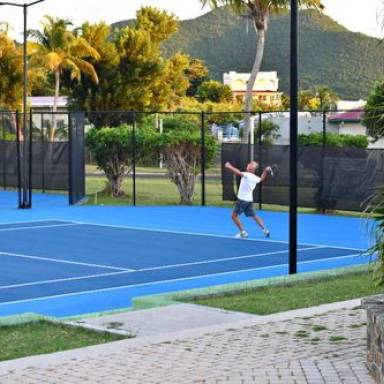The St. Maarten Nature Foundation, several students from Milton Peters College (MPC), and the Jorakhae Free Diving School recently re-planted approximately 200 mangrove trees at Mullet Pond. These vital plants, like much of the island’s ecosystem, have taken substantial damage from over development of the coastline and high winds and waves during hurricane Irma.

Mangroves are a unique type of tree that can grow and survive in fresh, brackish or saltwater. This rare ability means that these plants can be found at the edge of shorelines, where freshwater and saltwater mix with sediments in the earth. The roots of the trees start above the water line and hold fast in the soft earth below. Their strength protects the coastline; if the plants are lost the land will erode away, making it impossible for the trees to re-grow in the same place.
The mangroves are so strong in fact, that many boats owners tied their vessels directly to the roots of the groves before Hurricane Irma. Instead of drifting away, these boats ended up on top of the plants, which held fast during the intense wind speeds of the storm.
Those boaters that relied on the mangroves to act as anchors left behind an incredible amount of debris to be cleaned. Washing machines, cabinets, toilets, anything that flew overboard, or needed to be dumped to lighten the load of the boat was tossed into the forest. Instead of acting as a home for marine-life and bird species these areas were treated as a dumping ground.
It’s strength and ability to live in salt water is not the only thing that sets the mangrove apart from other trees. Mangroves can absorb an amazing amount of carbon dioxide from the air we breathe, making them far more affective in combating climate change than other forest areas.
Not only can these plants help clean the air around them, they act as a natural filtration system for the water that runs through their roots. The trees actually absorb toxins and trap sediments, making the water around them cleaner.
With so many benefits it is easy to see why organizations like The SXM Nature Foundation and EPIC (Environmental Protection in the Caribbean) have made efforts to re-introduce the mangroves to our ecosystem.
These projects are vital as more than half of the mangroves that were native to the island were damaged or destroyed by Hurricane Irma.
“More people should see the value of mangroves and their protection. There should be a much larger scale of mangrove restoration,” said Project Officer Melanie Meijer zu Schlochtern, “Mullet Pond is the last intact mangrove forest in Simpson Bay Lagoon and provides vital protection.” There is a conservation zone around Mullet Pond area that protects these plants, but it is limited to a very small area.
To begin this process the Nature Foundation brought in seeds from a company in Florida with funding from the Dutch Caribbean Nature Alliance. “We started growing the seeds neat our location in Cole Bay over five months ago,” stated Schlochtern.
There are several different ways you can approach the process of growing and re-planting mangrove trees. As seedlings these trees are delicate and can be wiped out by winds or high boat traffic. To combat this mangroves can either be transplanted after they have grown to a more stable size, or they can be planted with some sort of protection around them until they are strong enough for it to be removed.
The Nature Foundation chose to grow their seedlings until they were large enough to be planted individually. This is not a simple task as the mangroves started out in fresh water and then were slowly introduced to salt water as they matured, “The plants need a little transition time, we had 3 students from MPC come and first introduced 25% salt water, then 50%, 75%. This helped the plants to grow quickly,” says Schlochtern.
Using the other tactic, the group EPIC planted some of their seedlings in December of 2018 with PVC pipe protection around them. This will later be removed once the plant is large enough to survive on it’s own.
Along with the efforts of the above organizations the residents of St. Maarten can help the regrowth of these areas by never tying their boats to these trees or their roots and never dumping debris in the mangrove forests.





























































